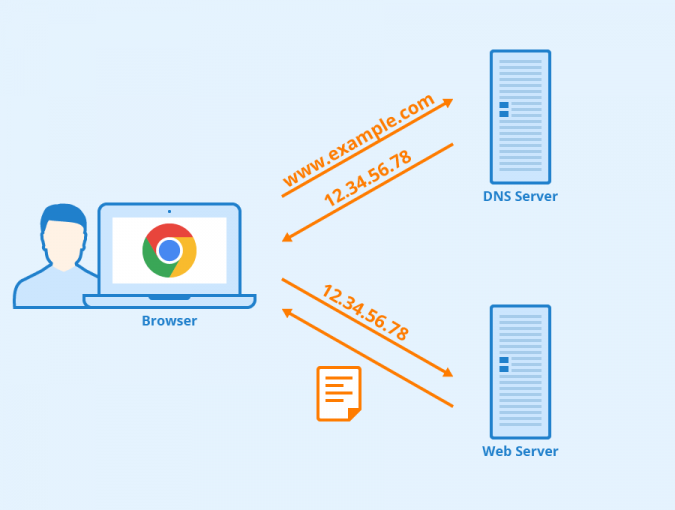
The Domain Name System (DNS) is a hierarchical, decentralised naming system for computers, services and other resources connected to the internet. It translates domain names (like yourfirm.com) to the numerical IP addresses needed for locating and identifying computer services and devices with the underlying network protocols (like 95.232.149.44). The DNS provides a worldwide, distributed directory service and is essential to the functionality of the internet.
Administration of namespaces
The DNS address space is managed globally by the Internet Assigned Numbers Authority (IANA) which also administers IP addresses.
IANA is a department of the Internet Corporation for Assigned Names and Numbers (ICANN), a non-profit organisation responsible for co-ordinating the maintenance and procedures of several databases related to the namespaces of the internet, ensuring the network’s stable and secure operation.
Its work has included policy development for internationalisation of the DNS, the introduction of new generic top-level domains (TLDs) and the operation of root name servers. The numbering facilities ICANN manages include the IP address spaces and assignment of address blocks to regional internet registries.
Five regional internet registries (RIRs) delegate number resources to their customers, local internet registries, internet service providers, and end-user organisations.
Top-level domains
IANA categorises domain names in the following groups of top-level domains (TLDs):
- infrastructure top-level domain – a single domain, the Address and Routing Parameter Area (ARPA) which is managed by IANA on behalf of the Internet Engineering Task Force for various purposes;
- generic top-level domains (gTLD) – top-level domains with three or more characters (eg .gov, .info);
- restricted generic top-level domains (grTLD) – managed under official ICANN accredited registrars;
- sponsored top-level domains (sTLD) – proposed and sponsored by private agencies or organisations that establish and enforce rules restricting the eligibility to use the TLD;
- country-code top-level domains (ccTLD) – two-letter domains established for countries or territories (eg .us, .uk, .au); with some historical exceptions, the code for any territory is the same as its two-letter ISO 3166 code;
- internationalised country code top-level domains (IDN ccTLD) – ccTLDs in non-Latin character sets (eg Arabic, Cyrillic, Hebrew, or Chinese); and
- test top-level domains (tTLD) – installed under .test for testing.
Generic top-level domains initially consisted of the six domains .gov, .edu, .com, .mil, .org, and .net. In 2012 applications for new gTLDs were opened and hundreds more have been approved, mostly reflecting names of companies, products and services, but also cities and generic names like .bank and .sport. The most popular gTLDs are currently .top, .loan, .xyz, .club and .online. Critics of the expansion include Esther Dyson, the founding chairperson of ICANN, who wrote that “it will create jobs for [lawyers, marketers and others] but little extra value.”
How the system works
The DNS designates authoritative name servers for each domain which assign domain names and map those names to internet resources. Network administrators may delegate authority over sub-domains of their allocated namespace to other name servers. This mechanism provides a distributed, fault tolerant service which was designed to avoid a single large central database.
The DNS also specifies the technical functionality of the database service that is at its core. It defines the DNS protocol, a detailed specification of the data structures and data communication exchanges used in the DNS, as part of the internet protocol suite.
A DNS name server stores the DNS records for a domain and responds with answers to queries against its database, translating between domain names and IP addresses. Whilst this may seem to require a simple process, in fact a DNS lookup requires 8 steps.
Although not intended to be a general purpose database, DNS can store records for other types of data for either automatic lookups or for human queries such as responsible person (RP) records. As a general purpose database the DNS has also been used in combating unsolicited email (spam) by storing a real-time black hole list.
Domain name disputes
Domain names have commercial value and ownership disputes frequently arise, generally because the domain name is similar to the complainant’s trade mark or trading name. Often the registrant has used it to target the complainant in some way.
When registering domain names, registrants sign up to arbitration procedures included in the contracts offered by the registrars to settle such disputes.
The Uniform Domain Name Dispute Resolution Policy (UDRP) initiated by WIPO and mandated by ICANN applies to gTLDs, as well as some others.
In the UK, Nominet’s Dispute Resolution Service (DRS) applies to .co.uk and .uk domain names.
Further reading
Wikipedia: Domain Name System
Cloudflare: What is DNS | How DNS Works
Adlex Solicitors: Domain Name Disputes Guide
Nick Holmes is Editor of the Newsletter. Email nickholmes@infolaw.co.uk. Twitter @nickholmes.
Image cc by SEObility.